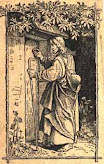Eucharistic Miracles of Florence, Italy (1230-1595)
 The reliquaries of two Eucharistic miracles which took place in 1230 and 1595 are held in Florence's Church of Saint Ambrose. In the 1230 miracle, a distracted priest left several drops of consecrated wine in the chalice after Mass. The next day, returning to celebrate Mass in the same church, he found in the chalice drops of living Blood coagulated and incarnated. The Blood was immediately kept in a crystal cruet. The other Eucharistic miracle took place on Good Friday in 1595, when several fragments of the Host were miraculously unharmed in a church fire.
The reliquaries of two Eucharistic miracles which took place in 1230 and 1595 are held in Florence's Church of Saint Ambrose. In the 1230 miracle, a distracted priest left several drops of consecrated wine in the chalice after Mass. The next day, returning to celebrate Mass in the same church, he found in the chalice drops of living Blood coagulated and incarnated. The Blood was immediately kept in a crystal cruet. The other Eucharistic miracle took place on Good Friday in 1595, when several fragments of the Host were miraculously unharmed in a church fire. The first miracle took place on December 30, 1230. A priest named Uguccione, having finished celebrating Mass, did not realize that several drops of consecrated wine remained in the chalice and had turned into Blood. The historian Giovanni Villani gives a precise description:
“A day later, taking up the chalice he found living Blood coagulated […] and this was shown to all the women of the monastery, and to all the locals who were present and to the bis hop and to all the clergy and then it was revealed to all the Florentines, who gathered with great devotion to see. He took the Blood from the chalice and put it in a crystal cruet and again showed it to the population with great reverence.” Bishop Ardingo of Pavia ordered that the reliquary be brought to him. He kept it for several weeks before returning it to the sisters of the monastery who took care of it near the Church of Saint Ambrose. Pope Boniface IX, in 1399, granted the same indulgence as the Portiuncula to those faithful who visited the Church of Saint Ambrose and contributed to adorning the reliquary of the miracle. The 750th anniversary of the miracle was celebrated in 1980. The Reliquary (several drops of blood that measure about a square centimeter) is conserved in a reliquary which has been place inside a white marble tabernacle constructed by Mimo da Fiesole.
hop and to all the clergy and then it was revealed to all the Florentines, who gathered with great devotion to see. He took the Blood from the chalice and put it in a crystal cruet and again showed it to the population with great reverence.” Bishop Ardingo of Pavia ordered that the reliquary be brought to him. He kept it for several weeks before returning it to the sisters of the monastery who took care of it near the Church of Saint Ambrose. Pope Boniface IX, in 1399, granted the same indulgence as the Portiuncula to those faithful who visited the Church of Saint Ambrose and contributed to adorning the reliquary of the miracle. The 750th anniversary of the miracle was celebrated in 1980. The Reliquary (several drops of blood that measure about a square centimeter) is conserved in a reliquary which has been place inside a white marble tabernacle constructed by Mimo da Fiesole.
 hop and to all the clergy and then it was revealed to all the Florentines, who gathered with great devotion to see. He took the Blood from the chalice and put it in a crystal cruet and again showed it to the population with great reverence.” Bishop Ardingo of Pavia ordered that the reliquary be brought to him. He kept it for several weeks before returning it to the sisters of the monastery who took care of it near the Church of Saint Ambrose. Pope Boniface IX, in 1399, granted the same indulgence as the Portiuncula to those faithful who visited the Church of Saint Ambrose and contributed to adorning the reliquary of the miracle. The 750th anniversary of the miracle was celebrated in 1980. The Reliquary (several drops of blood that measure about a square centimeter) is conserved in a reliquary which has been place inside a white marble tabernacle constructed by Mimo da Fiesole.
hop and to all the clergy and then it was revealed to all the Florentines, who gathered with great devotion to see. He took the Blood from the chalice and put it in a crystal cruet and again showed it to the population with great reverence.” Bishop Ardingo of Pavia ordered that the reliquary be brought to him. He kept it for several weeks before returning it to the sisters of the monastery who took care of it near the Church of Saint Ambrose. Pope Boniface IX, in 1399, granted the same indulgence as the Portiuncula to those faithful who visited the Church of Saint Ambrose and contributed to adorning the reliquary of the miracle. The 750th anniversary of the miracle was celebrated in 1980. The Reliquary (several drops of blood that measure about a square centimeter) is conserved in a reliquary which has been place inside a white marble tabernacle constructed by Mimo da Fiesole. On Good Friday in 1595, a lit candle on the altar of a side chapel called t he Sepulchre, fell to the ground and started a fire. The population immediately rushed to put out the fire and succeeded in saving the Blessed Sacrament and chalice. In the great commotion, six fragments of consecrated Hosts fell from the pyx onto the smoldering carpet, but despite the fire were found intact and joined together. In 1628, Archbishop Marzio Medici of Florence examined them and found them incorrupt. He had them placed in a precious reliquary. Every May during the Forty Hours devotion, the two reliquaries are exposed together in a reliquary that also contains a consecrated Host for public adoration.
he Sepulchre, fell to the ground and started a fire. The population immediately rushed to put out the fire and succeeded in saving the Blessed Sacrament and chalice. In the great commotion, six fragments of consecrated Hosts fell from the pyx onto the smoldering carpet, but despite the fire were found intact and joined together. In 1628, Archbishop Marzio Medici of Florence examined them and found them incorrupt. He had them placed in a precious reliquary. Every May during the Forty Hours devotion, the two reliquaries are exposed together in a reliquary that also contains a consecrated Host for public adoration.
 he Sepulchre, fell to the ground and started a fire. The population immediately rushed to put out the fire and succeeded in saving the Blessed Sacrament and chalice. In the great commotion, six fragments of consecrated Hosts fell from the pyx onto the smoldering carpet, but despite the fire were found intact and joined together. In 1628, Archbishop Marzio Medici of Florence examined them and found them incorrupt. He had them placed in a precious reliquary. Every May during the Forty Hours devotion, the two reliquaries are exposed together in a reliquary that also contains a consecrated Host for public adoration.
he Sepulchre, fell to the ground and started a fire. The population immediately rushed to put out the fire and succeeded in saving the Blessed Sacrament and chalice. In the great commotion, six fragments of consecrated Hosts fell from the pyx onto the smoldering carpet, but despite the fire were found intact and joined together. In 1628, Archbishop Marzio Medici of Florence examined them and found them incorrupt. He had them placed in a precious reliquary. Every May during the Forty Hours devotion, the two reliquaries are exposed together in a reliquary that also contains a consecrated Host for public adoration. 














